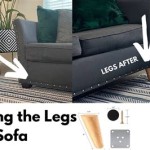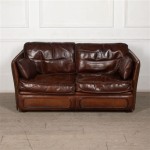How To Clean Up An Old Leather Sofa At Home
Maintaining the appearance and longevity of a leather sofa necessitates regular cleaning and care. Over time, leather can accumulate dirt, dust, body oils, and stains, diminishing its aesthetic appeal and potentially leading to damage. While professional cleaning services offer specialized treatments, many effective cleaning methods can be performed at home, saving considerable expense and allowing for convenient maintenance. This article provides a comprehensive guide to cleaning an old leather sofa at home, covering essential preparations, cleaning techniques, stain removal strategies, and preventative maintenance tips.
Before initiating any cleaning process, it is crucial to identify the type of leather your sofa is made from. Different leather types require specific cleaning approaches to prevent damage or discoloration. The most common types of leather used in sofas include:
- Aniline Leather: Also known as pure aniline or naked leather, this type is dyed exclusively with soluble dyes, retaining the natural surface of the hide. It is highly susceptible to staining and requires gentle cleaning methods.
- Semi-Aniline Leather: This leather undergoes a similar dyeing process to aniline leather but has a light protective coating applied to enhance its durability and stain resistance.
- Protected Leather (Finished Leather): This is the most durable type of leather, featuring a polymer surface coating that makes it resistant to stains, scratches, and fading. It is also the easiest to clean.
- Nubuck Leather: Similar to suede, nubuck leather is buffed to create a soft, velvety texture. It is highly absorbent and requires specialized cleaning products.
Identifying the leather type is often indicated on the furniture's tag or manufacturer's label. If the tag is unavailable, perform a water drop test. Place a small drop of water on an inconspicuous area of the sofa. If the water absorbs quickly, the leather is likely aniline. If it beads up, it is probably protected leather. Semi-aniline leather will absorb water slower than aniline but faster than protected leather. Nubuck leather will darken significantly upon contact with water.
Preparing for the Cleaning Process
Prior to commencing the cleaning process, thorough preparation is critical to protect the sofa and ensure effective results. This involves gathering the necessary supplies and taking preliminary steps to remove loose debris.
Gather the following materials:
- Soft cloths: Microfiber cloths are ideal, as they are gentle on leather and effectively lift dirt and dust. Avoid using abrasive cloths.
- Soft-bristled brush: A brush with soft bristles is useful for reaching crevices and gently loosening dirt.
- Vacuum cleaner with upholstery attachment: This is essential for removing loose debris from the sofa's surface and crevices.
- Leather cleaner: Choose a leather cleaner specifically formulated for the type of leather your sofa is made of. Test the cleaner on an inconspicuous area before applying it to the entire sofa.
- Distilled water: Distilled water is preferable to tap water, as it is free of minerals and chemicals that can potentially stain or damage leather.
- Leather conditioner: Applying a leather conditioner after cleaning helps to replenish the leather's natural oils and prevent it from drying out and cracking.
- Buckets: One bucket for clean water and another for rinsing cloths.
- Optional: Leather stain remover, saddle soap (for specific cleaning needs), and white vinegar (for certain stains).
Before applying any cleaning products, vacuum the entire sofa thoroughly. Use the upholstery attachment to remove loose debris, dust, and pet hair from the surface, crevices, and cushions. Pay particular attention to areas where dirt tends to accumulate, such as seams and folds. After vacuuming, wipe down the entire sofa with a dry microfiber cloth to remove any remaining loose particles.
Before applying any cleaning product to the entire sofa, it is crucial to perform a spot test in an inconspicuous area, such as the back or underside of the sofa. This will help determine whether the cleaner causes any discoloration or damage to the leather. Apply a small amount of the cleaner to the test area, let it sit for a few minutes, and then wipe it off with a clean cloth. Observe the area for any adverse reactions, such as color loss, staining, or changes in texture. If no adverse reactions occur, you can proceed with cleaning the rest of the sofa.
Cleaning the Leather Sofa
Once the preparations are complete, the actual cleaning process can begin. The specific cleaning method will vary depending on the type of leather and the severity of the soiling.
For general cleaning, mix a small amount of leather cleaner with distilled water according to the manufacturer's instructions. Dip a clean microfiber cloth into the solution, wring it out thoroughly so that it is damp but not soaking wet, and gently wipe down the entire surface of the sofa. Avoid applying excessive pressure or rubbing vigorously, as this can damage the leather. Work in small sections, overlapping each pass to ensure even coverage.
For areas with stubborn dirt or grime, use a soft-bristled brush to gently scrub the affected area. Be careful not to apply too much pressure, as this can scratch the leather. After scrubbing, wipe the area with a clean, damp cloth to remove any residual cleaner and dirt.
After cleaning the entire sofa, wipe it down with a clean, damp cloth to remove any remaining cleaner residue. This is important to prevent the cleaner from drying on the leather and causing a sticky or unsightly appearance. Ensure the cloth is wrung out thoroughly to avoid over-wetting the leather.
Allow the sofa to air dry completely. Avoid using a hairdryer or placing it in direct sunlight, as this can cause the leather to dry out and crack. It is best to allow the sofa to dry naturally in a well-ventilated area. The drying time will vary depending on the humidity and temperature.
Once the sofa is completely dry, apply a leather conditioner to replenish the leather's natural oils and prevent it from drying out and cracking. Follow the manufacturer's instructions for applying the conditioner. Typically, this involves applying a small amount of conditioner to a clean cloth and gently rubbing it into the leather in a circular motion. Allow the conditioner to absorb into the leather for the recommended time, and then buff the surface with a clean cloth to remove any excess conditioner.
Addressing Specific Stains and Issues
Certain types of stains require specialized cleaning methods. Prompt action is essential for successful stain removal.
Oil Stains: Blot the stain immediately with a clean, dry cloth to absorb as much oil as possible. Sprinkle cornstarch or baking soda on the stain and let it sit for several hours to absorb the remaining oil. Vacuum up the powder and wipe the area with a clean, damp cloth.
Ink Stains: Attempt to blot the ink stain immediately with a clean, dry cloth. If the ink remains, try using a leather stain remover specifically designed for ink removal. Follow the manufacturer's instructions carefully. Alternatively, a cotton swab dampened with rubbing alcohol can be gently dabbed on the stain, followed by wiping with a clean, damp cloth. Test in an inconspicuous area first.
Water Stains: Blot the stain with a clean, dry cloth. If the water stain persists, dampen a clean cloth with distilled water and gently wipe the entire area around the stain to blend it in. Allow the area to air dry completely.
Mold and Mildew: Mix equal parts of distilled water and white vinegar in a spray bottle. Lightly spray the affected area and let it sit for a few minutes. Wipe the area with a clean, damp cloth and allow it to air dry completely. Ensure the area is well-ventilated to prevent the mold from returning.
Scratches and Scuffs: For minor scratches and scuffs, a leather conditioner can often help to minimize their appearance. For more severe scratches, consider using a leather repair kit or consulting with a professional leather repair specialist.
Regular maintenance is crucial for preserving the beauty and extending the lifespan of a leather sofa. Vacuum the sofa regularly to remove loose debris and prevent dirt from becoming embedded in the leather. Wipe down the sofa with a damp cloth every few weeks to remove surface dirt and oils. Apply leather conditioner every 6-12 months to keep the leather supple and prevent it from drying out and cracking. Avoid placing the sofa in direct sunlight or near heat sources, as this can cause the leather to fade and crack. Use leather protectors to avoid scratches and spills when necessary.

Leather Couch Cleaning And Restoration

How To Fully Repair And Recondition A Leather Couch Poly Bark Part 1 Of 3

Leather Sofa Restoration How To Re Faded

Can You Steam Clean A Leather Sofa Answers By Fantastic Cleaners

How To Clean A Leather Couch Best Way Condition And Furniture

How To Clean A Couch

Best Way To Clean Your Couch Sofa Microfiber For Amazing Results Detergent Baking Soda
How To Clean Leather Comprehensive Guide Bees Housekeeping

How To Repair A Ling Faux Leather Sofa Coconix

How To Re Leather Furniture With One








